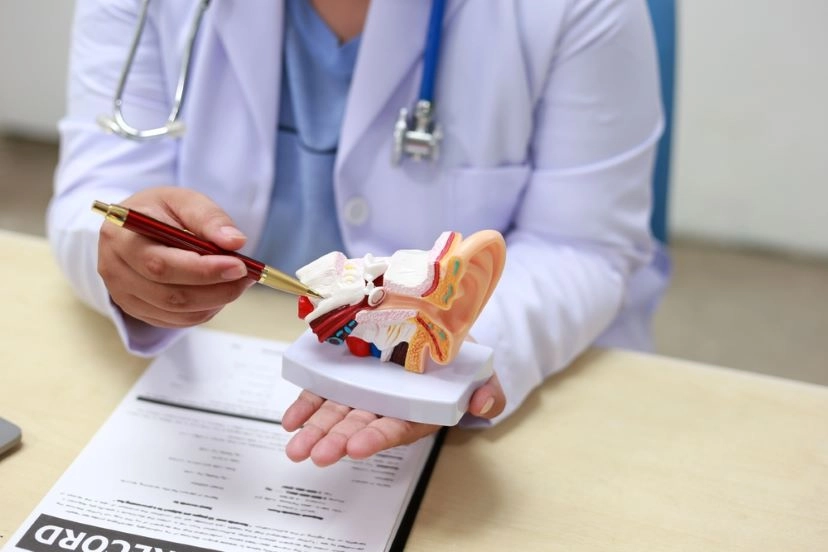Acute Otitis Media : More Dangerous Than You Think!

Acute otitis media is a rapidly developing infection of the middle ear, especially common in young children. If left untreated, it can lead to serious complications. This article will help you understand the causes, symptoms, diagnostic methods, and proper treatment options, along with preventive tips to maintain healthy and safe ears.
What Is Acute Otitis Media?
Acute otitis media is an inflammation of the middle ear caused by a viral or bacterial infection. It is most commonly seen in young children because their Eustachian tubes — which connect the nasal cavity to the middle ear — are more susceptible to inflammation following respiratory infections, such as the common cold or sinusitis. When the Eustachian tubes become swollen and function abnormally, pathogens can easily enter and infect the middle ear.
Causes and Risk Factors
Acute otitis media typically develops after an upper respiratory tract infection. Key causes and risk factors include:
1. Viral or bacterial infections such as the common cold and sinusitis
2. Swelling or blockage of the Eustachian tube, which connects the nasal passage to the middle ear
3. Spread of infection through the Eustachian tube, allowing germs to reach the middle ear
Close contact with infected individuals during outbreaks can increase the risk of developing the condition
Symptoms of Acute Otitis Media
The symptoms of acute otitis media can vary depending on age. Common signs include:
In young children:
- High fever and frequent crying or irritability
- Sensitivity or resistance to having their ears touched, due to ear pain
In adults:
- A feeling of ear fullness or reduced hearing
- Fluid discharge from the ear, especially if the inflammation causes a ruptured eardrum
These symptoms should be closely monitored, and medical attention should be sought promptly to prevent potential complications.
Possible Complications
If acute otitis media is not treated properly and promptly, it may lead to serious complications, such as:
- Facial paralysis: Caused by the infection spreading to the facial nerve
- Swelling and redness behind the ear: A sign that the infection has spread beyond the middle ear
- Neck swelling: May occur if the infection extends to surrounding tissues and other parts of the body
Timely and appropriate medical care is essential to reduce the risk of these complications.
Diagnosis of Acute Otitis Media
If acute otitis media is suspected, patients should consult an ear specialist for an accurate diagnosis. The diagnostic process typically involves:
- Medical history and physical examination: To assess symptoms and determine the severity of the inflammation
- Otoscopy (ear examination): A special instrument is used to inspect the eardrum for redness and check for fluid buildup in the middle ear
- Additional tests: In cases of severe symptoms or complications, further tests may be performed to evaluate the condition of the eardrum and other parts of the ear system
Treatment Options for Acute Otitis Media
Treatment for acute otitis media may involve medication or surgery, depending on the underlying cause and severity of symptoms.
1. Medication-Based Treatment
- Antibiotics: Prescribed when the infection is caused by bacteria
- Pain relievers: To reduce ear pain and discomfort
- Decongestants or nasal sprays: Help reduce inflammation and relieve Eustachian tube blockage
2. Surgical Treatment
- Myringotomy (ear drainage procedure): May be necessary in cases with complications or when the infection spreads to other areas. In children, surgery is sometimes required to drain fluid and relieve pressure in the middle ear
Choosing the appropriate treatment method and ensuring close medical follow-up are essential steps in restoring ear health.
Prevention and Ear Health Care Guidelines
To prevent acute otitis media and reduce the risk of complications, the following measures are recommended:
- Avoid contact with individuals with respiratory infections: This helps reduce the chance of contracting viruses or bacteria that may lead to middle ear inflammation
- Take care during a cold or flu: If you develop symptoms of a cold or suspect a middle ear infection, consult a doctor promptly for proper treatment
- Maintain good personal hygiene: Keeping clean and maintaining overall health can help lower the risk of infection
Conclusion
Acute otitis media is a common condition, especially in children, and can lead to serious complications if left untreated. Early symptom recognition and timely diagnosis by a specialist are essential. Treatment typically involves antibiotics and careful monitoring, and in some cases, surgical drainage may be necessary. For healthy ears and effective disease prevention, it is important to practice good hygiene and seek medical attention immediately when experiencing unusual ear symptoms.


